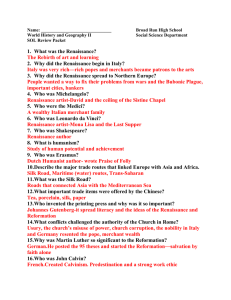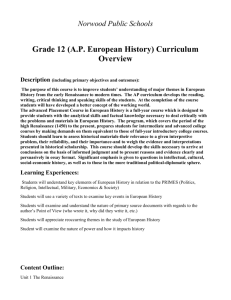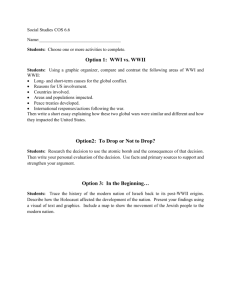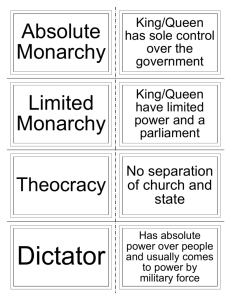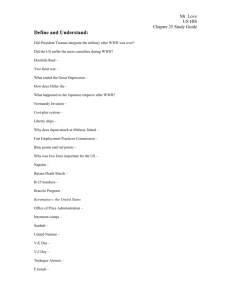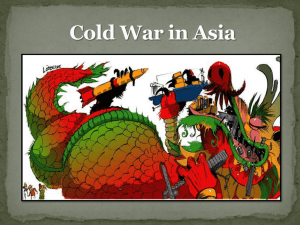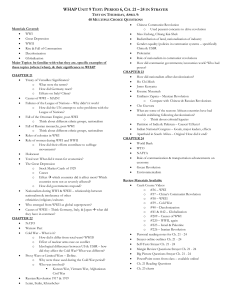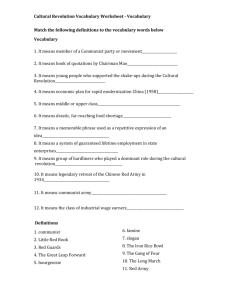Name: Broad Run High School - Loudoun County Public Schools
advertisement
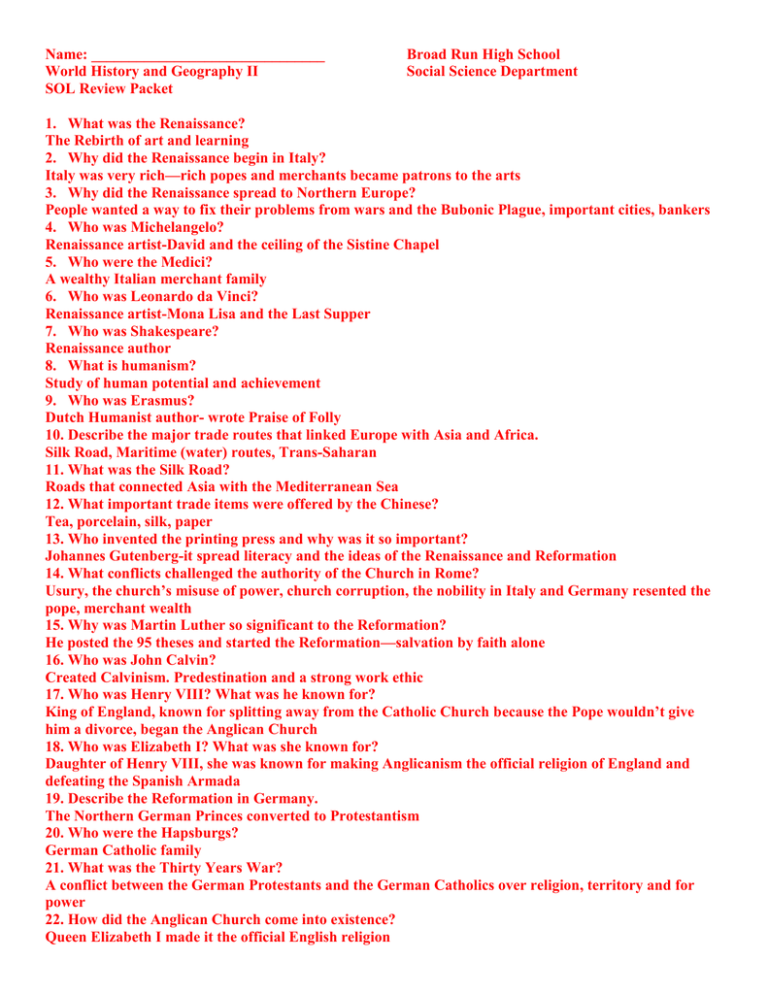
Name: _______________________________ World History and Geography II SOL Review Packet Broad Run High School Social Science Department 1. What was the Renaissance? The Rebirth of art and learning 2. Why did the Renaissance begin in Italy? Italy was very rich—rich popes and merchants became patrons to the arts 3. Why did the Renaissance spread to Northern Europe? People wanted a way to fix their problems from wars and the Bubonic Plague, important cities, bankers 4. Who was Michelangelo? Renaissance artist-David and the ceiling of the Sistine Chapel 5. Who were the Medici? A wealthy Italian merchant family 6. Who was Leonardo da Vinci? Renaissance artist-Mona Lisa and the Last Supper 7. Who was Shakespeare? Renaissance author 8. What is humanism? Study of human potential and achievement 9. Who was Erasmus? Dutch Humanist author- wrote Praise of Folly 10. Describe the major trade routes that linked Europe with Asia and Africa. Silk Road, Maritime (water) routes, Trans-Saharan 11. What was the Silk Road? Roads that connected Asia with the Mediterranean Sea 12. What important trade items were offered by the Chinese? Tea, porcelain, silk, paper 13. Who invented the printing press and why was it so important? Johannes Gutenberg-it spread literacy and the ideas of the Renaissance and Reformation 14. What conflicts challenged the authority of the Church in Rome? Usury, the church’s misuse of power, church corruption, the nobility in Italy and Germany resented the pope, merchant wealth 15. Why was Martin Luther so significant to the Reformation? He posted the 95 theses and started the Reformation—salvation by faith alone 16. Who was John Calvin? Created Calvinism. Predestination and a strong work ethic 17. Who was Henry VIII? What was he known for? King of England, known for splitting away from the Catholic Church because the Pope wouldn’t give him a divorce, began the Anglican Church 18. Who was Elizabeth I? What was she known for? Daughter of Henry VIII, she was known for making Anglicanism the official religion of England and defeating the Spanish Armada 19. Describe the Reformation in Germany. The Northern German Princes converted to Protestantism 20. Who were the Hapsburgs? German Catholic family 21. What was the Thirty Years War? A conflict between the German Protestants and the German Catholics over religion, territory and for power 22. How did the Anglican Church come into existence? Queen Elizabeth I made it the official English religion 23. Who were the Huguenots? French protestants 24. What was the Edict of Nantes? Huguenots were given the freedom to worship 25. Who was Cardinal Richelieu? A French cardinal who changed the 30 Years War from Religious to Political 26. Before Martin Luther, there was ____John Hus_____ and __John Wycliffe___________ who called for reforms in the Catholic Church. 27. What was the Counter Reformation? A series of reforms (fixes) made by the Catholic Church 28. What was the Council of Trent? A meeting of the church that tried to fix the problems and reaffirmed the Catholic rules. 29. Who were the Jesuits? (Society of Jesus) Priests who educated people about Catholicism and conducting missionary work 30. What was the Inquisition? A court established to reinforce Catholic doctrine through punishment and torture 31. What factors contributed to the European discovery of land in the Western Hemisphere? A need for gold, spices, and natural resources; support for spreading Christianity; political and economic competition between European Empires; innovations in navigational arts 32. Who was Prince Henry the Navigator? A Prince of Portugal who founded a school for navigation that helped start exploration 33. Who was Vasco da Gama? Portuguese explorer who found a route to India 34. Who was Christopher Columbus? Explorer for Spain who sailed to the Americas 35. Who was Hernando Cortez? Spanish conquistador who conquered the Aztecs 36. Who was Francisco Pizarro? Spanish conquistador who conquered the Incas 37. Who was Ferdinand Magellan? Spanish explorer known for circumnavigating the world 38. Who was Sir Francis Drake? First British man to sail around the world 39. Who was Jacques Cartier? French explorer who discovered Canada 40. How did Christianity spread to the “New World?” The Europeans forced it upon the native populations, missionaries 41. What led to the demise of the Aztecs, Incas, and Mayas? They were conquered by Spanish conquistadors; disease 42. Describe the rigid class system in Latin America. It was similar to Europe, with Europeans on top, and slaves on the bottom. Mining and farming, encomiendas 43. What is a colony? A land controlled by a distant nation 44. What was the Middle Passage? Trip to the Americas for slaves from Africa—middle leg of Triangular Trade 45. Why did Europeans turn to Africa for slaves? Africans had built up immunity to disease, had farming experience, and had little knowledge of America so it was harder for them to run away 46. What was the Columbian Exchange? Exchange of goods between the Americas, Africa, and Europe 47. Where was the Ottoman Empire located? Asia Minor (present-day Turkey), spread to North Africa, parts of Europe, and the Middle East 48. What is the importance of the Ottoman Empire? (what contributions did they make?) Istanbul established, used Islam to unify the empire, traded coffee and ceramics 49. Where was the Mughal Empire located? Northern India 50. What is the importance of the Mughal Empire? (what contributions did they make?) Spread Islam into India, built the Taj Mahal, Indian textiles influenced the British 51. What did Southern India trade? Silks, gems, spices 52. Describe the class system in Japan (shogunate). Weak emperors were ruled by military leaders (shoguns) 53. Why did the Japanese and Chinese stay relatively isolated from Europe? They wanted to limit outside (foreign) influences 54. What is mercantilism? An economic policy where a countries’ power depends on its wealth. Increased by obtaining large amounts of gold and silver and by selling more goods than they buy 55. What is the Commercial Revolution? The expansion of trade and business based on trade, credit and banking, and colonies, that transformed European economies during the 16th and 17th centuries 56. Who was Nicolaus Copernicus? Creator of the heliocentric theory 57. Who was Johannes Kepler? Discovered the laws of planetary motion 58. Who was Galileo Galilei? Supporter of the heliocentric theory 59. Who was Isaac Newton? Discovered the laws of gravity 60. Who was William Harvey? Discoverer of blood circulation 61. What was the Scientific Revolution? A new way of thinking in Europe based on careful observation, a willingness to question widely held beliefs, and reason 62. What is absolutism and divine right? Ruling without limits and controlling all aspects of scoiety. DR: god gives kings the right to rule 63. Who was the Sun King? Louis XIV—King of France who built the palace at Versailles 64. Who was Louis XVI? Grandson of Louis IV—King of France during the French Revolution 65. Who was Frederick the Great? King of Prussia—focused society on the military 66. Who was Peter the Great? King of Russia—focused on westernizing his country, built St Petersburg 67. How did the English Civil War promote the rights of Englishmen? Parliament vs. the King, created a limited monarchy 68. How did the Glorious Revolution promote the rights of Englishmen? The GR increased parliamentary power over royal power, and it led to the creation of the English Bill of Rights 69. Who was Oliver Cromwell? The leader of the Puritans in the English Civil War. Executed Charles I and ruled as a military dictator 70. What was the Restoration? Charles II restored to the throne in England 71. What was the English Bill of Rights of 1689? Established the limits on the English monarchy. 72. What was the Enlightenment? An intellectual movement in which thinkers tried to apply reason and the scientific method to society 73. Who was Thomas Hobbes? Wrote Leviathan—Humans are evil and primitive and consent to government for self-protection. Likes absolute monarchies 74. Who was John Locke? Wrote Two Treatisies on Government—People have the power in government. They also have natural rights to life, liberty, and property. 75. Who was Montesquieu? Wrote The Spirit of Laws—separation of powers in government 76. Who was Jean-Jacques Rousseau? Wrote The Social Contract—Government is a contract between the rulers and the people 77. Who was Voltaire? Enlightenment thinker—religious tolerance should be the rule; separation of church and state 78. How did the Enlightenment influence Thomas Jefferson and the Declaration of Independence? TJ used Enlightenment ideas in the Declaration of Independence—life, liberty, and property 79. How did the Enlightenment influence the US Constitution and Bill of Rights? Those documents used Enlightenment ideas such as religious freedom, separation of powers, and government as a social contract 80. What were the causes of the French Revolution? The Old Regime, Enlightenment ideas, influence of the American Revolution 77. What was the Reign of Terror? The period in French history when the government was led by Maximillian Robespierre who, executed anyone who spoke against him 80. Describe the colonial system (government, religion, economy). The colonial system was a mirror of the mother country in terms of government and religion. Their economy existed to help the mother country. 81. Describe the class structure in the colonial system. Peninsulars (men born in Spain)Creoles (Spainards born in USA)Mestizos (European/Indian)Mulattos (European/African) 82. What two events influenced revolutions in Central and South America? The American and French Revolutions 83. What countries gained their independence in the 1800s? Haiti, Venezuela, Chile, Peru, Mexico, Brazil 84. Who was Toussaint L’Ouverture? Leader of a slave revolt in Haiti 85. Who was Simon Bolivar? The general who led the revolution in Venezuela 86. What was the Monroe Doctrine? Written in 1823—American document that told European countries to stay out of the Americas 87. Who was Johann Sebastian Bach? A baroque composer 88. Who was Wolfgang Amadeus Mozart? A classical composer 89. Who was Eugene Delacroix? A Romantic artist 90. Who was Voltaire? See number 77 91. Who was Miguel de Cervantes? Europe’s first novelist—wrote Don Quixote 92. Who was Napoleon? The Emperor of France after the French Revolution. Known for the Napoleonic Code 93. What was the Napoleonic Code? A unifed code of law for all men; supported the idea of giving up personal rights for the good of the nation 94. What happened at the Congress of Vienna? Restored Kings to power, redrew the map of Europe, and established a balance of power among European nations 95. What is the balance of power doctrine? The idea of not allowing any one country to be more powerful than another 96. What is liberalism? The idea of wanting a government based on a constitution 97. What is conservatism? The idea of wanting governments to return to absolute monarchies 98. What was the significance of the Revolutions of 1848? The revolutions signify an increase in nationalistic tensions 99. Who was Count Cavour? Unified northern Italy 100. Who was Giuseppe Garibaldi? The leader responsible for uniting southern Italy 101. How was Italy unified? Garibaldi gave southern Italy to Cavour, and the Papal States joined last, uniting the nation. 102. How was Germany unified? Otto von Bismarck led Prussia in the unification of GE through war and by appealing to nationalistic feelings 103. Who was Otto von Bismarck? The leader of Prussia who followed Realpolitik and who was known for uniting Germany 104. What was Realpolitik? A philosophy that justifies all means to preserve power 105. What is the significance of the Franco-Prussian War? Germany unified 106. What is the Agricultural Revolution? New designs in farm tools and technology led to an increase in food 107. What is the Industrial Revolution? The shift (beginning in England) from making goods by hand to making goods by machine 108. What is the enclosure movement? The practice of hedging in fields in order to make larger and more productive fields 109. What raw materials were important to industrialization? Water, iron ore, coal, steel 110. Why did the Industrial Revolution begin in England? England had the right raw materials, rivers for inland transportation, harbors for ocean trade 111. Who was James Watt? Creator of the steam engine 112. Who was Eli Whitney? Creator of the cotton gin 113. Who was James Hargreaves? Creator of the spinning jenny 114. Who was Henry Bessemer? Creator of the process of making steel 115. Who was Edward Jenner? Creator of the smallpox vaccine 116. Who was Louis Pasteur? Discoverer of bacteria 117. What is urbanization? The movement of people from the country to the cities to find work 118. What working conditions were workers dissatisfied with? Long hours, dangerous conditions, low pay, child labor 119. What is capitalism? People freely investing money to make profit 120. Who wrote Wealth of Nations? Adam Smith 121. What is laissez-faire? No government interference in business 122. Who was Karl Marx and what did he write? The founder of the idea of Communism who wrote the Communist Manifesto 123. What were the benefits of child labor? Costs were low and the profits high 124. What caused the rise of labor unions? Dissatisfaction with working conditions and a desire for higher pay 125. What is collective bargaining? Labor and management working together to determine fair pay 126. What benefits do labor unions provide? They lobbied for laws to benefit workers, they encouraged strikes for higher wages 127. What is nationalism? Having pride/love for your country 128. What is imperialism? A stronger country taking over a weaker country for its own gain 129. What are protectorates? Areas who has its own government, but its foreign policy is controlled by an outside nation 130. What are spheres of influence? (think China) Areas whose trade and economy are controlled by an outside nation. 131. How was Japan opened to trade in the 19th century? The United States forced it open 132. What is the significance of the Suez Canal? It provided a direct sea route between Europe and Asia 133. What was the Boxer Rebellion? A rebellion by the Chinese peasants to protest foreign influences in China 134. What was the Sepoy Rebellion? A rebellion by Indian soldiers to protest British rule in India and led to harsher treatment of India by the British. 135. What were the causes of World War I? IMANASS—Imperialism, Militarism, Nationalism, Alliances, Assassination of Archduke Ferdinand 136. What were the major events of WWI? Assassination of Ferdinand, US enters war in 1917, Russia leaves the war 137. What were the effects of WWI? Increased colonial demands for independence, it ended the Russian, Ottoman, German, and AustriaHungary Empires, and there was a HUGE cost of the war in lives, property, and social disruption 138. What is the Treaty of Versailles? A treaty after WWI that forced Germany to accept all guilt for the war, lose territory, limit their military, and pay reparations. It also formed the League of Nations. 139. Who was Woodrow Wilson? President of the US in WWI—created the 14 Points 140. What is the League of Nations? An international peacekeeping group without an army to enforce its decisions and the US was not a member 141. What caused the Bolshevik Revolution? Landless peasantry, the incompetence of Nicolas II, military defeats and high casualties in WWI 142. Who was Lenin? The leader of the Bolsheviks 143. What is communism? An economic system in which all means of production are owned by the people—everything is shared 144. What is the mandate system? After WWI, large parts of the former Ottoman Empire in the Middle East were temporarily divided and ruled by Great Britain or France 145. What were the causes of the worldwide depression of the interwar period? high German reparations, high tariffs, too much credit being given out, and the dominance of the U.S. economy that crashed with the Stock Market Crash of 1929 146. Who was Joseph Stalin? Describe his policies. Russian/Soviet dictator in the Interwar and WWII years. Policies-strong Communism, 5 year plans, collectivization of farms, secret police, state industrialization. 147. Who was Adolf Hitler? Describe his policies. German Nazi dictator. Policies-anti-semitism, Nazism, extreme nationalism, occupation of nearby countries 148. Who was Benito Mussolini? Describe his policies. Italian Fascist dictator. Policies—ambition to restore the glory of Rome, invasion of Ethiopia 149. What is fascism? A political movement that promotes an extreme form of nationalism, denial of individual rights and a one party rule 150. Explain how Japan was imperialistic prior to and in WWII. It was imperialistic because it needed raw materials. It invaded Korea, China, Manchuria 151. Who was Hideki Tojo? Hirohito? Tojo-military general of Japan Hirohito-Emperor of Japan 152. Who was Douglas Mac Arthur? U.S. General during WWII—responsible for the Pacific 153. Who was Winston Churchill? Prime Minister of Great Britain during WWII 154. Who was Dwight D. Eisenhower? U.S. General during WWII—responsible for Europe 155. Who was George Marshall? U.S. General—creator of the Marshall Plan 156. What was the Holocaust? The extermination of Jews, blacks, gypsies, homosexuals, handicapped, etc during WWII through the Final Solution. 157. What is genocide? The systematic and purposeful destruction of a racial, political, religious, or cultural group 158. What was the final solution? The plan for carrying out the Holocaust in germany involving the use of extermination camps with gas chambers 159. Give two examples of genocide. (other than the Holocaust) Cambodia (Pol Pot)—genocide of the educated, Rwanda—Hutus killing the Tutsis, Armenians by the Ottoman Empire, The Great Purge by Stalin in the Soviet Union, 160. What was D Day? June 6, 1945--The day of the largest amphibious landing in world history that led to an Allied victory in WWII. 161. Who was FDR? Harry Truman? U.S. President at the beginning of WWII; U.S. President at the end of WWII and for the beginning of the Cold War 162. Why is the invasion of Poland significant? It marked the beginning of WWII 163. Why is Stalingrad significant? The German loss stopped the German advance into the Soviet Union—turning point of the war 164. Where were the atomic bombs dropped? Hiroshima and Nagasaki (Japan) 165. What was the outcome of WWII? The Allies won, leading to the collapse of European Empires and the establishment of the U.S. and the USSR as the two big powers 166. What is the United Nations? An international cooperative organization dedicated to keeping peace 167. What is the Universal Declaration of Human Rights? Made by the UN—it provided a code of conduct for the treatment of people under the protection of a government. 168. What is NATO? North Atlantic Treaty Organization—created by democratic nations to cooperate against Communism 169. What is the Iron Curtain? A “wall” between the communist countries in the East and the democratic countries in the West of Europe 170. What happened at Nuremburg? WWII war crimes trials where Nazis were tried for their actions in WWII 171. What was the Yalta Conference? US, Britain, and USSR met to create a postwar plan—divided up Germany between them and France, gave the USSR Eastern European countries 172. What is the Marshall Plan? The U.S. plan to give aid to any European nation that needs it after WWII to prevent Communism from spreading to them 173. What is containment? The policy of keeping communism from spreading 174. What was the Cold War? Political and ideological rivalry between the U.S. (democracy/capitalism) and the USSR (Communist) 175. What was the Cuban Missile Crisis? A confrontation between the United States, the Soviet Union, and Cuba in October 1962, during the Cold War. The Soviet Union was placing nuclear missiles in Cuba only 90 miles away from the US 176. What is significant about the Korean War? Fought between North Korea(communist) and South Korea(Democratic)—ended with the country divided at the 38th parallel 177. What is significant about the Vietnam War? Started due to the domino theory—the U.S. had to back out of the war and Vietnam became communist 178. What is the domino theory? If one country falls to communism, the others will follow 179. What is the Warsaw Pact? USSR’s response to NATO—an alliance of Eastern European communist countries 180. What was the Berlin Wall? Wall separating East and West Berlin--symbol of Communist tyranny to the West 181. Who was Chiang Kai-shek (Jiang Jieshi)? Where did he go? Chinese Nationalist leader—he fled to southwest China (Taiwan) 182. Who was Mao Tse-tung (Mao Zedong)? Chinese Communist leader 183. Who was Ho Chi Minh? Vietnamese Communist leader 184. Who is Krushchev? Brezhnev? Gorbechev? Soviet leaders. Kruschchev—Cuban Missile Crisis and destalinization; Gorbachev—glasnost and perestroika 185. Who is Indira Gandhi? Prime Minister of India during Cold War 186. Who is Margaret Thatcher? Prime Minister of Great Britain during Cold War 187. Who is Deng Xiaoping? Leader of China after Mao—relaxed some of Communist rules 188. How did Indian independence come about? Indian demands for self-rule and the change in British policies led to India’s independence 189. Who was Mohandas Ghandi? Leader of the independence movement in India—nonviolent techniques 190. What is civil disobedience and passive resistance? CD—deliberate and public refusal to obey a law considered unjust. PR—nonviolent noncooperation 191. What divides Pakistan and India? Political division along Hindu-Muslim lines 192. Describe Indian democracy. Largest democratic nation in world; most power held in the central government 193. Explain the independence movements of Africa. Right to self-determination led to both peaceful and violent moves for independence. Prompted by: pride in African cultures and heritage resentment toward imperial rule and economic exploitation, loss of colonies 194. Example of West Africa? Nonviolent protests, strikes and boycotts against Britain 195. Example of Algeria? FLN violence against France 196. Example of Kenya? (Britain)—violent struggle under the leadership of Jomo Kenyatta 197. Example of South Africa? Black South Africans struggle against apartheid—led by Mandela 198. What is apartheid? Complete legal segregation of races in South Africa 199. Who is Nelson Mandela? Leader of South African independence movement; jailed for many years but becomes SA’s first black president 200. Why is the Middle East a world “hot spot”? Competing religious and ethnic divisions 201. Explain the Arab-Israeli conflict. Dispute over Palestine between the Jews (Israel) and the Muslims(Palestinians) 202. Who is Golda Meir? Israeli prime minister during the Yom Kippur War 203. Who is Nasser? Egyptian President who nationalized the Suez Canal and built the Aswan Dam 204. Explain Judaism. (location?) Founder: Abraham Book: Torah Location: Israel, North America Beliefs: monotheistic, Ten Commandments 205. Explain Christianity. (location?) Founder: Jesus Christ Book: Bible Location: Europe, Middle East, North America Beliefs: monotheistic, Ten Commandments, Jesus as son of god, life after death 206. Explain Islam. (location?) Founder: Mohammed Book: Koran Location: Middle East, Africa, Asia Beliefs: monotheistic, Five Pillars of Islam, Mecca and Medina 207. Explain Hinduism. (location?) Founder: no one founder Book: Upanishads, Vedas Location: India Beliefs: polytheistic, Moksha, Caste System, Karma, reincarnation 208. Explain Buddhism. (location?) Founder: Buddha, Siddhartha Gautama Book: Four Noble Truths, Eightfold Path Location: East, Southeast Asia Beliefs: Four Noble Truths, Eightfold Pat, Nirvana, Ashoka spread Buddhism 209. What is a refugee? People seeking safety from war or persecution in another nation 210. What is the difference between a developed and a developing nation? A developed nation has everything needed for the advanced production of industrialized goods and a developing nation is in the process of obtaining what’s needed to become industrialized 211. What environmental challenges face the world today? More pollution, loss of habitat, global climate change 212. What social challenges face the world today? Poverty, poor health, illiteracy, famine, migration 213. What is the European Union? Example of regional integration—economic and political union of 27 member nations 214. What is NAFTA? North American Free Trade Agreement—eliminated trade restrictions between USA, Canada, Mexico 215. What is the WTO? Int’l organization created to supervise international trade and support free trade 216. What is the IMF? International Monetary Fund—gives out emergency loans to countries in a crisis 217. What is terrorism? Use of violence and threats to intimidate and coerce for political reasons 218. Give 5 examples of international terrorism. Munich Olympics, 9/11 attacks, suicide bombings, airplane hijacking, car bombings 219. Give 3 government responses to terrorist activities. Surveillance increased, personal rights decrease, security increased, identification required 220. Know your geography skills!!!!!!!!
